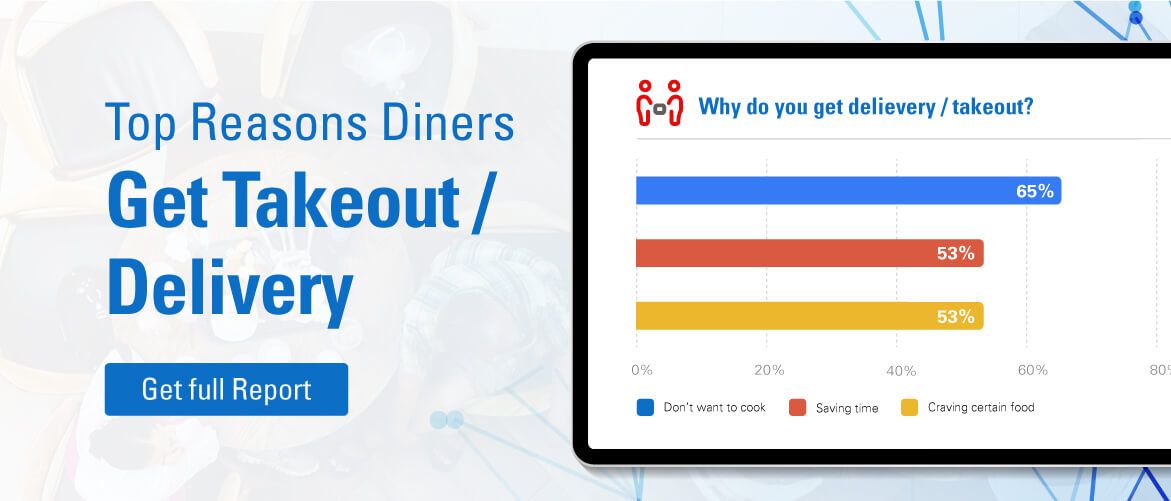Takeout and delivery have been a lifeline for many restaurants the past couple of years. Although dining-in has been gradually returning, the biggest growth for restaurants has still been takeout and delivery, and some of the restaurants that most successfully weathered the pandemic did so by pivoting quickly towards takeout and delivery.
Take Out and Delivery are Here to Stay
The culture shift to takeout and delivery is unlikely to go away.
In fact, Azira’s recent study, The New World of Consumer Behavior: Restaurants 2022, found that 57% of diners consider it a nice-to-have to be able to order takeout or delivery from a restaurant, and 8% of respondents said that they will only consider a restaurant that does takeout and delivery.
Combine that with 65% of respondents that say they get delivery or takeout simply because they don’t want to cook, and another 53% that consider it to be a time-saver. More than a quarter of respondents also specifically stated that they continue to order out because they’re still wary of catching Covid from dining indoors.
Another reason for the growth of delivery and takeout, and why it will likely continue into the future, is that many diners discovered a preference for outdoor dining. Even with the growth of dining-in, a significant group of diners surveyed actually still prefer outdoor seating when available, whether as a part of the restaurant or not. 52% of respondents said they consider outdoor seating essential or nice to have.

Embracing Digital Options for Takeout and Delivery
Another reason for the success of takeout and delivery is that there are now many more options and forms of takeout and delivery, many of which are digital-based. Pre-pandemic, mobile app-based delivery was in its early stages, online ordering via websites was uncommon, and takeout had to be done over the phone, in person or through drive-thrus. All of those options are no longer nice-to-haves for restaurants. They’ve become necessities, critical to restaurants that want to reach a wide range of dining audiences, particularly those not interested in dining in.
Mobile, in particular, has changed the takeout game and has actually overtaken the drive-thru as the leading source for takeout by volume and revenue, per Bluedot. Much of this is due to mobile apps, which have created a host of alternative ordering methods that can be tailored by region, specific store, or even specific individual. According to research by Sensor Tower, quick-service app downloads in 2020 grew by 21 percent, reaching 83 million and surpassing the growth of third-party app downloads.
Delivery via website and delivery apps are critical as well. Being on a takeout and delivery app is very important for diners between the ages of 18-44, with 48% stating that they’re more likely to order food from restaurants that are listed in takeout and delivery apps.
Read the report: The New World of Consumer Behavior: Restaurants 2022
Rethinking Site Selection for Delivery & Takeout
Restaurants that know their audience includes diners with a preference for takeout and delivery can use this information for site selection. They can choose new locations that may have smaller footprints, less space for indoor tables, and also locations with good road traffic to allow for smooth takeout and delivery options. They can also select sites that are close to popular outdoor seating areas, making takeout more appealing and removing the need for more indoor seating and other indoor maintenance.
Another innovation driven by restaurants that know delivery is a large portion of its customer base is the use of ghost kitchens, which have seen a significant rise in popularity during the pandemic to serve the growing consumer demand for delivery.
Restaurants that want to use ghost kitchens must use a different set of criteria for site selection than a traditional location. While they don’t need to be located in places with high foot traffic or even drive-by traffic, they do need to be strategically positioned near population centers and highways to ensure efficient delivery times.
How Restaurant Brands Can Optimize Around Takeout and Delivery
It’s clear coming out of the pandemic, that consumers expect many of the conveniences that emerged around takeout and delivery to stick around. Restaurants oriented towards takeout and delivery should continue:
- Offering streamlined options for ordering takeout and delivery online and on apps
- Ensuring quick delivery and convenient takeout service by selecting and optimizing sites for takeout
- Providing a positive drive-thru experience optimized for personalized customer service and short wait times
- Giving options for outdoor dining, or selecting sites near picnic areas
These are just a few of the examples of how consumer expectations around the dining experience have changed in the last few years.
Want to learn more about trends in dining? Read the full report: The New World of Consumer Behavior: Restaurants 2022
Study Methodology
Takeout and delivery have been a lifeline for many restaurants the past couple of years. Although dining-in has been gradually returning, the biggest growth for restaurants has still been takeout and delivery, and some of the restaurants that most successfully weathered the pandemic did so by pivoting quickly towards takeout and delivery.



